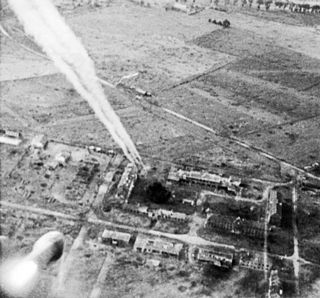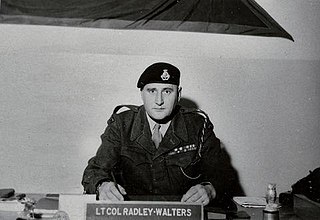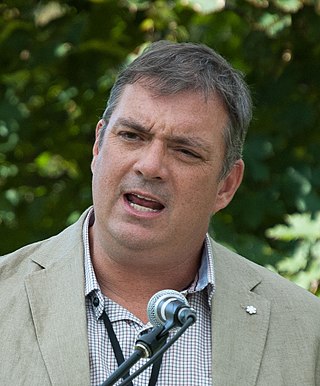
Field Marshal Bernard Law Montgomery, 1st Viscount Montgomery of Alamein,, nicknamed "Monty", was a senior British Army officer who served in the First World War, the Irish War of Independence and the Second World War.

Michael Wittmann was a German Waffen-SS tank commander during the Second World War. He is known for his ambush of elements of the British 7th Armored Division during the Battle of Villers-Bocage on 13 June 1944. While in command of a Tiger I tank, Wittmann destroyed up to 14 tanks, 15 personnel carriers and two anti-tank guns within 15 minutes before the loss of his own tank.

Operation Totalize was an offensive launched by Allied troops in the First Canadian Army during the later stages of Operation Overlord, from 8 to 9 August 1944. The intention was to break through the German defences south of Caen on the eastern flank of the Allied positions in Normandy and exploit success by driving south, to capture the high ground north of the city of Falaise. The goal was to collapse the German front and cut off the retreat of German forces fighting the Allied armies further west. The battle is considered the inaugural operation of the First Canadian Army, which had been activated on 23 July.

The SS Division Hitlerjugend or 12th SS Panzer Division "Hitlerjugend" was a German armoured division of the Waffen-SS during World War II. The majority of its junior enlisted men were drawn from members of the Hitler Youth, while the senior NCOs and officers were from other Waffen-SS divisions. Most of the Division Enlisted Soldiers, were of Teenagers starting from the ages of 16 or even 15.

General Henry Duncan Graham Crerar was a senior officer of the Canadian Army who became the country's senior field commander in the Second World War as commander of the First Canadian Army in the campaign in North West Europe in 1944–1945. A graduate of the Royal Military College of Canada, in Kingston, Ontario, Crerar was commissioned as a lieutenant in the Non-Permanent Active Militia in 1909, serving with the 4th Battery, Canadian Field Artillery, which was based in Hamilton, Ontario. He rose to the rank of lieutenant-colonel in the artillery in the First World War, during which he was mentioned in despatches and made a member of the Distinguished Service Order (DSO). Electing to remain in the army as a professional soldier after the war, he attended the Staff College, Camberley, from 1923 to 1924, and the Imperial Defence College in 1934. He was appointed Director of Military Operations & Military Intelligence in 1935 and Commandant of the Royal Military College of Canada in 1939.

Lieutenant-General Guy Granville Simonds, was a senior Canadian Army officer who served with distinction during World War II. Acknowledged by many military historians and senior commanders, among them Sir Max Hastings and Field Marshal Sir Bernard Montgomery, as one of the best Canadian generals of the war, Simonds, after serving the first few years of the Second World War mainly as a staff officer, commanded the 1st Canadian Infantry Division with distinction in Sicily and Italy from July 1943 until January 1944, and later II Canadian Corps during the Battle of Normandy from June−August 1944 and throughout the subsequent campaign in Western Europe from 1944, towards the end of which he temporarily commanded the First Canadian Army during the Battle of the Scheldt, until victory in Europe Day in May 1945. The historian J. L. Granatstein states the following about Simonds: "No Canadian commander rose higher and faster in the Second World War, and none did as well in action. Simonds owed his success wholly to his own abilities and efforts—and those of the men who served under him."

The history of Canada during World War II begins with the German invasion of Poland on 1 September 1939. While the Canadian Armed Forces were eventually active in nearly every theatre of war, most combat was centred in Italy, Northwestern Europe, and the North Atlantic. In all, some 1.1 million Canadians served in the Canadian Army, Royal Canadian Navy, Royal Canadian Air Force, out of a population that as of the 1941 Census had 11,506,655 people, and in forces across the empire, with approximately 42,000 killed and another 55,000 wounded. During the war, Canada was subject to direct attack in the Battle of the St. Lawrence, and in the shelling of a lighthouse at Estevan Point on Vancouver Island, British Columbia.
Joseph William Ekins was a British soldier. He gained recognition for his action as a British Army tank gunner in France during World War II, in which Ekins destroyed four German tanks near Saint-Aignan-de-Cramesnil in a day, including three Tiger I tanks. One of his opponents on that day, 8 August 1944, was the German tank commander Michael Wittmann; whether Ekins fired the round that destroyed Wittmann's Tiger is disputed. Ekins died on 1 February 2012.

Operation Spring was an offensive operation of the Second World War conducted by II Canadian Corps during the Normandy campaign in 1944. The plan was intended to create pressure on the German forces operating on the British and Canadian front simultaneous with Operation Cobra, an American offensive. Operation Spring was intended to capture Verrières Ridge and the villages on the south slope of the ridge. The German defence of the ridge contained the offensive on the first day and inflicted many casualties on the Canadians.

Major General Rodney Frederick Leopold Keller CBE was a notable Canadian Army officer who rose to divisional-level command in the Second World War. He commanded the 3rd Canadian Infantry Division which was assigned to take Juno Beach during the D-Day invasion.

The Battle of Verrières Ridge was a series of engagements fought as part of the Battle of Normandy, in Calvados, during the Second World War. The main combatants were two Canadian infantry divisions—with additional support from the Canadian 2nd Armoured Brigade—against elements of three German SS Panzer divisions. The battle was part of the British and Canadian tacks south of Caen, and took place from 19 to 25 July 1944, being part of Operation Atlantic and Operation Spring.
Lieutenant-Colonel (Retd) Roman Jarymowycz, OMM, CD, Ph.D. was a decorated Canadian soldier and military educator. He was also a student of Canadian military history and made important contributions to the contemporary debate about Canada and the Normandy campaign in World War II.

The 272nd Infantry Division was a Type 1944 Infantry division of the German Wehrmacht during World War II, that was originally formed in December 1943. The division fought in many of the major battles throughout Operation Overlord, culminating in the Retreat from Northern France and the Low Countries in late August/early September 1944.

Operation Windsor(4–5 July 1944), was a Canadian attack of the Battle of Normandy during the Second World War. The attack was undertaken by the 3rd Canadian Infantry Division to take Carpiquet and the adjacent airfield from troops of the 12th SS-Panzer Division Hitler Jugend of Panzergruppe West. The attack was originally intended to take place during the later stages of Operation Epsom, to protect the eastern flank of the main assault but was postponed for a week.

Sydney Valpy Radley-Walters CMM, DSO, MC, CD, nicknamed "Rad", was a tank commander in the Canadian Army. Credited with 18 German tanks and many other armoured vehicles, he was the leading Western Allies' tank ace of the Second World War.

Clearing the Channel Coast was a World War II task undertaken by the First Canadian Army in August 1944, following the Allied Operation Overlord and the victory, break-out and pursuit from Normandy.

The First Canadian Army was a field army and a formation of the Canadian Army in World War II in which most Canadian elements serving in North-West Europe were assigned. It served on the Western Front from July 1944 until May 1945.

Tim Cook is a Canadian military historian and author. Cook is an historian at the Canadian War Museum and the author of thirteen books about the military history of Canada. Having written extensively about World War I, Cook's focus shifted to Canada's involvement in World War II with the 2014 publication of the first volume in a two-volume series chronicling Canada's role in that war. He is a two-time recipient of the C.P. Stacey Prize, a two-time recipient of the J.W. Dafoe Book Prize, and a three-time winner of the Ottawa Book Prize. He was elected to the Royal Society of Canada in 2019. He is a member of the Order of Canada.
David R. O'Keefe is a Canadian historian, television presenter, and writer. He is known for presenting War Junk alongside Gemini nominated and Emmy award-winning producer and director Wayne Abbott. He has appeared on television and radio networks including CBC Radio, Global Television, CTV Television Network, UKTV Network and History TV channel.
The Battle for Hill 140 was fought on 9 August, 1944 as part of Operation Totalize between a battle group from the 4th Canadian Division and German troops, mainly from the 12th SS Panzer Division "Hitlerjugend". It unfolded near a village in Normandy, Estrées-la-Campagne, when during a night attack, the Canadian troops deviated from the axis of advance, occupying an area contrary to the orders of their own command. The consequence of the mistake was the complete destruction of the Canadian troops by a German counterattack that lasted several hours. It was an unprecedented case during the Normandy campaign, and probably the entire World War II, for such a large force to lose track of the terrain, lose its way and consequently be completely wrecked.















